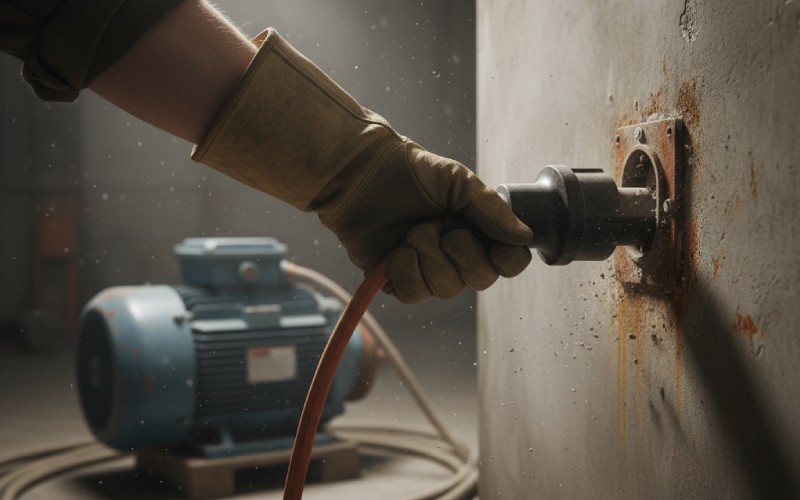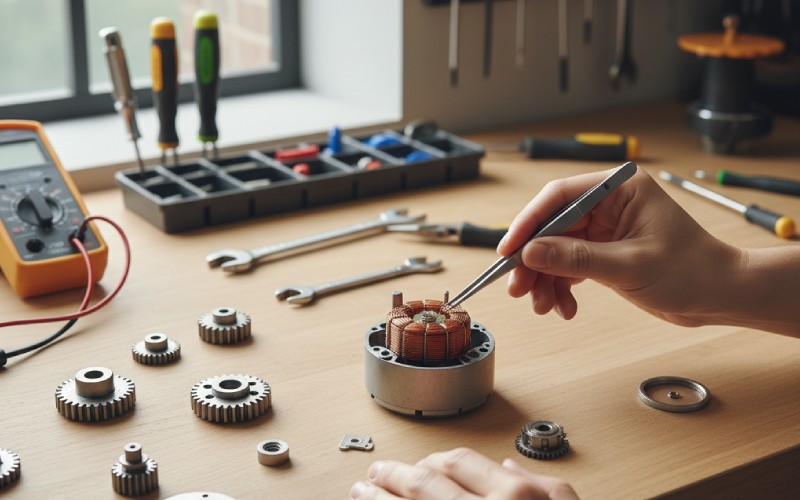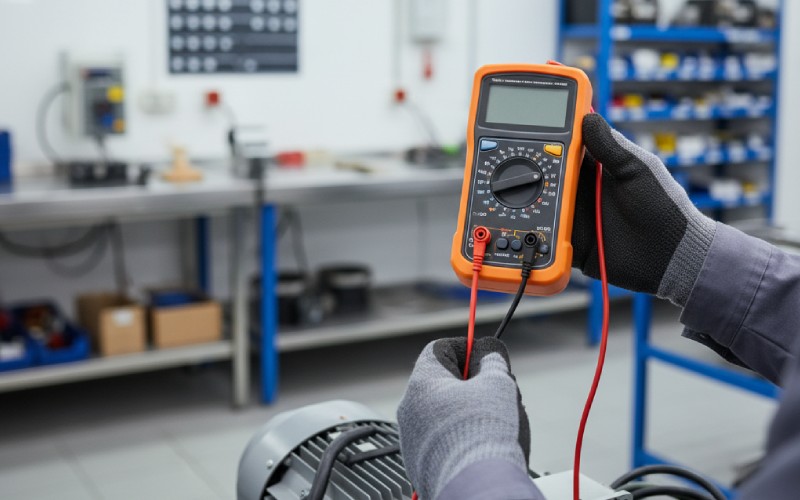Let Sino's Lamination Stacks Empower Your Project!
To speed up your project, you can label Lamination Stacks with details such as tolerance, material, surface finish, whether or not oxidized insulation is required, quantity, and more.

Is your electric motor making a weird sound? Or maybe it just quit working? Hold on before you rush out to buy a new one. Many problems with a motor are not hard to find. This guide is here to help you. We will show you easy ways to test if your motor is no good. You can save time and money when you know how to find the problem on your own. This article is helpful because it gives you easy steps that anyone can do to find the fault in a motor.
Before you pick up a tool, think about safety first. Working with an electric motor can be a danger if it still has power. The first and most important step is to cut off the power to the motor. This means you should unplug it from the wall. Or you can turn off the circuit breaker that sends power to it. Be sure that no one can turn it on by mistake while you are working. You do not want any unexpected electrical shocks.
Never just think a motor is off because it is not moving. You should always check for yourself. If you are working in a shop or a big factory, be sure to follow all the safety rules. If you do not know how to safely cut the power to the motor, it is a good idea to ask a professional for help. This one simple check can stop you from getting badly hurt. Doing the test safely is just as important as getting a correct reading. Always put your own safety first when you test any motor.
After the motor is safely powered off, your first test is done with your eyes and nose. A good look-over can tell you many things. Look at the motor’s outside part, which is called the frame. Do you see any cracks, deep scratches, or big holes? Take a look at the paint. Are there any dark spots that look burned? A burned spot on the frame can be a sign that the motor will overheat on the inside. This is a sure sign of a problem.
Also, look for anything that doesn’t look right. Check the places where the wires connect at the motor terminal box. Are any wires not tight, broken, or do they look burned? A bad wire can make a motor stop working the right way. You should use your nose, too. A smell like something electrical is burning is a very strong sign that the motor winding has gone bad. You should also check for any dirt or junk that could block the air holes. A motor has to stay cool, and blocked air holes can cause a fault. This easy look-over is a big part of finding the problem.
A motor has parts that move, and these parts can break down. The shaft is the part of the motor that turns around. You should check it with your hands. With all the power off, try to spin the motor shaft. Does it turn easily and without making noise? Or does it feel like it is stuck, hard to turn, or makes a scraping sound? A scraping sound is often a sign of a bad bearing. The bearings are small parts inside that help the shaft spin with no trouble. Most motors have one bearing in the front and one in the rear.
If the shaft is hard to turn, the bearing could be bad. You can also try to move the shaft up and down and from side to side. It should feel tight, not loose. If it moves around a lot, the bearing is old and bad. A bad bearing can make the motor work too hard, and then it can fail. Sometimes, a bearing will fail because it does not have enough oil or grease. A simple hand test of the shaft and bearing can help you find a problem with its moving parts before you even need a tool. This is a very good way to check the motor.

For the next parts of the test, you will need a special tool. The best tool to test an electric motor for electrical problems is a multimeter. A multimeter is a tool that can check a few different things. For our motor test, we will use its ohmmeter setting. An ohmmeter checks for electrical resistance. We measure resistance in a unit called an ohm. But do not worry, it is very easy to use.
A digital multimeter is the best kind to use. It gives you a number on a screen that is easy to read. You will use the multimeter to see if the motor winding is okay. The winding is a big coil of wire that is inside the motor. Electricity goes through this wire, and that is what makes the motor spin. If the winding has a break in it, or a short, the motor will not work at all. A multimeter is the only tool that can see this electrical problem you cannot see. It is a tool you really need for any motor repair.
This test checks to see if the path for electricity through the winding is complete. To start, turn the dial on your multimeter to the resistance setting. This setting often has the symbol for an ohm (Ω). Before you begin the test, touch the two metal tips of the multimeter leads together. The reading on the screen should change to zero or a number very close to zero. This lets you know that your multimeter is working as it should.
Next, find the electrical wires that come out of the motor. For a basic, single-phase AC motor, you will probably see three wires. You will need to test the resistance for each pair of wires. For instance, if the wires are red, black, and white, you will do three tests. You will test red to black, red to white, and then black to white. Touch one multimeter lead to the metal end of one wire. Then, touch the other lead to another wire. Write down the ohm reading you get for each pair. This reading will tell you if the path through the winding is not broken.
The numbers you get from your multimeter will tell you about the motor winding. You are looking for a certain kind of reading. A good winding will give you a low resistance reading. The number can be a little different for every motor. But it should be a low number of ohms. It should not be zero, and it should not be infinite. The main thing is to get a steady number.
This table shows what your readings can mean:
| Multimeter Reading | What It Means | Motor Condition |
|---|---|---|
| A low ohm reading (like 2-20 ohms) | The winding is okay. The electrical path is complete. | Good |
| Infinite resistance (shows “OL” or “1”) | The winding is open. There is a break in the wire. | Bad |
| Zero ohms or a number very close to it | The winding has a short. The electricity found a shortcut. | Bad |
If you get a reading that is infinite, it means the wire inside the motor is broken. The motor will have to be replaced or brought to a shop for repair. If your reading is zero, the winding has a short. This can also mean the motor has failed. To get a reading you can trust, be sure the multimeter leads are touching the motor wires on a clean metal spot.
Another problem that often happens with motors is a “short to ground.” This is when the electrical winding inside a motor makes contact with the metal frame of the motor. This is a very bad fault. It can put electricity on the outside of the motor, which can shock you. Your multimeter can test for this problem very easily.
To do this test, keep your multimeter set to resistance (ohm).
For this test, you hope to see an infinite reading (“OL”). A reading that is infinite means there is no electrical path from the winding to the frame. This is good. If you get any kind of ohm reading, even if the number is very big, it means there is a short to ground fault. A motor that has this fault is a danger to use. It needs to be taken to a shop for a repair, or you need to replace it.
Many large machines or ones in factories use a three-phase motor. Testing this kind of motor is a lot like the other test, but there is one more step. A three-phase motor has three windings of its own. The wires for these are often marked with the letters U, V, and W. You have to test the resistance between each phase.
You will need to do three resistance tests:
For a three-phase motor that is working well, all three of these resistance readings should be very, very close to each other. The numbers should be the same. If one reading is not close to the other two, it is a sign of a fault in that winding. You should also do the short to ground test on a three-phase motor. You do this by checking each wire (U, V, and W) to the motor frame.

Many motors use a fan to help them stay cool. This fan is most often on the outside of the motor and has a cover over it. It is really important that this fan is working. If the fan is broken, or something is blocking it, the motor will get too hot. This can hurt the winding in a short time. The fan is an easy part to check.
With the power turned off, look at the blades on the fan. Are any of them broken or gone? A broken fan cannot move enough air. You should also check for any junk. As time goes by, things like dirt, dust, and leaves can block up the fan and its cover. You can use a brush or some canned air to clean it all out. While you are there, be sure the fan is on there tight on the motor shaft. A quick fan check is an easy part of regular care that can stop a big motor problem from happening. A working fan will help your motor last for a long time.
After you finish testing your motor, you should know what is wrong with it. You were able to find out what the problem is. Maybe you found a bad bearing. Or maybe you found an open winding or a short to ground fault. Now you have to figure out the next step. You can usually choose to repair the motor or to replace it with a new one.
For small motors that you see a lot, it is usually cheaper and quicker to just replace the motor. It is easy to find a new motor. You just have to be sure the new motor uses the same voltage (volt), has the same horsepower, and has the same frame size. If your motor is a large one, or an expensive industrial motor, a repair might be a better idea. A professional motor repair shop has the right tools to fix a winding or replace a bearing. They can make an old motor work just like it was new. Knowing how to check your motor will help you make a smart choice. It could also save your shop a lot of money.